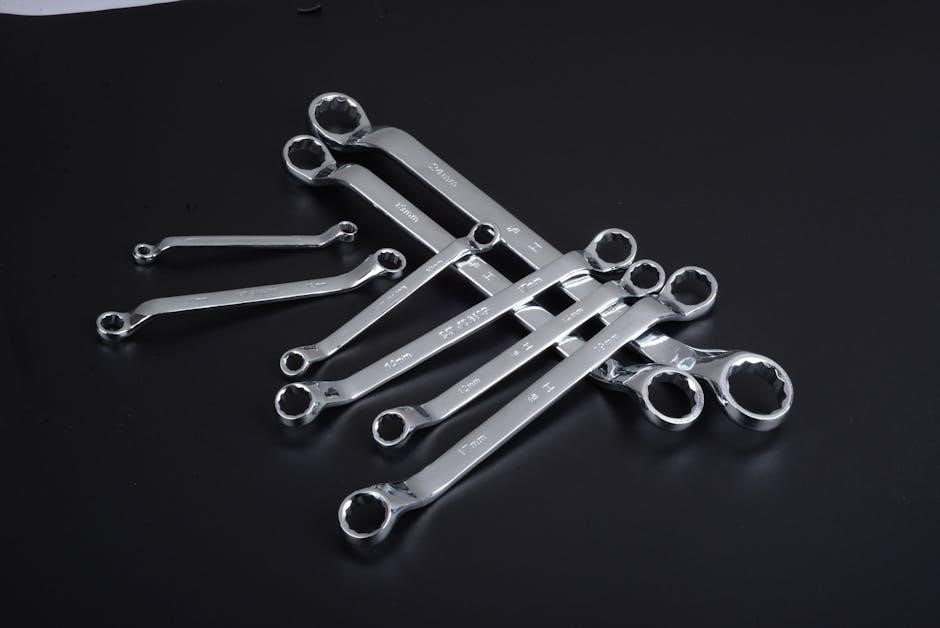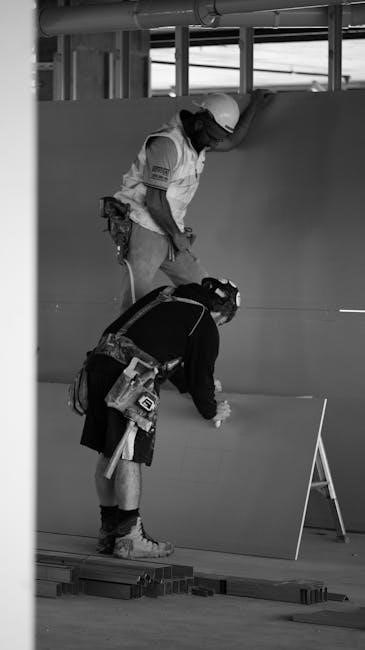Plumbing tools are essential for installing, maintaining, and repairing plumbing systems. They include pipe cutters, wrenches, pliers, and threading tools. These tools help plumbers perform tasks efficiently, ensuring proper water flow and system integrity. Understanding their uses is vital for success in plumbing.
Categories of Plumbing Tools
Plumbing tools are categorized by function: cutting tools (e.g., pipe cutters, reamers), holding tools (e.g., wrenches, pliers), fitting tools (e.g., tube benders), and threading tools (e.g., manual threaders). Each category addresses specific tasks in plumbing systems.
2.1 Cutting Tools
Cutting tools are essential in plumbing for preparing pipes and tubes. Common types include pipe cutters, which are used to cut various pipe materials like PVC, copper, and steel. These tools come in different sizes, such as small diameter pipe cutters and large tube cutters, ensuring precision cuts. Another key tool is the ratchet cutter, which provides ease of use with its adjustable design. For more specialized tasks, tools like the 4-wheel pipe cutter offer additional functionality. These cutters often feature replaceable blades and are designed for durability, making them suitable for frequent use in professional settings. Proper use of cutting tools ensures smooth, clean edges, which are crucial for fitting and connecting pipes effectively. By having the right cutter for the job, plumbers can maintain efficiency and accuracy in their work, whether on a construction site or in a residential setting.
2.2 Holding Tools
Holding tools are indispensable in plumbing for securely gripping and stabilizing pipes and fittings during repairs or installations. One of the most common holding tools is the pipe wrench, which is available in adjustable and fixed jaw designs. These wrenches are ideal for holding pipes firmly, preventing them from moving during cutting or fitting processes. Another essential holding tool is the slip-joint plier, which provides a strong grip on various pipe sizes and types. Additionally, clamps such as C-clamps or pipe clamps are widely used to hold pipes in place, ensuring stability while soldering or welding. These tools are typically made from durable materials like cast iron or aluminum, ensuring long-term reliability. Proper use of holding tools prevents damage to pipes and fittings, making the plumbing process safer and more efficient. Whether it’s a small residential job or a large-scale industrial project, having the right holding tools is crucial for achieving professional results.
2;3 Fitting Tools
Fitting tools are specialized instruments used in plumbing to connect, seal, and assemble pipe fittings securely. These tools ensure that connections are leak-proof and durable. One common fitting tool is the tube bender, which is used to bend pipes into specific shapes without causing damage. Another essential tool is the flaring tool, which creates flared ends on metal pipes to prepare them for fittings. Additionally, die stocks and dies are used to create threads on pipes, enabling them to connect with threaded fittings. Socket sets are also crucial for attaching and detaching fittings, providing a secure grip on various pipe sizes. Fitting tools are typically made from high-quality steel or aluminum, ensuring longevity and reliability. Proper use of these tools is vital for maintaining the integrity of plumbing systems. Whether it’s residential or industrial plumbing, fitting tools play a key role in ensuring that all connections are made safely and effectively. Their precision and versatility make them indispensable for any plumber.

Essential Tools for Plumbers
Essential tools for plumbers include pipe wrenches, pliers, tape measures, and tubing cutters. These tools are crucial for measuring, cutting, and tightening pipes and fittings. They ensure efficiency and precision in plumbing tasks, making them indispensable for professionals.
3.1 Pipe Wrenches
Pipe wrenches are among the most essential tools for plumbers, designed to grip and twist pipes and fittings. They are available in various sizes, such as 14-inch models, and are typically made of durable materials like cast iron or aluminum. These wrenches feature adjustable jaws that securely clamp onto pipes, allowing for precise control during installation or repair. A 14-inch pipe wrench, for instance, is commonly used for larger pipes and fittings, making it a staple in many plumbing kits. Some models, like the 48-22-7114, are priced around $33.50, offering affordability without compromising on quality. Pipe wrenches are indispensable for applying the necessary torque to tighten or loosen connections, ensuring leak-free seals. Their robust construction and ergonomic design make them a reliable choice for professionals. Whether for residential or commercial projects, pipe wrenches are a fundamental tool that every plumber must have in their arsenal.
3.2 Pliers
Pliers are versatile hand tools used by plumbers to grip, bend, and shape various materials. They are available in different types, each designed for specific tasks. Channel lock pliers, for example, are ideal for gripping objects like pipes and fittings, while slip-joint pliers are useful for loosening stuck parts. Needle-nose pliers are perfect for reaching tight spaces, and tongue-and-groove pliers offer adjustable jaws for gripping objects of different sizes. These tools are essential for tasks such as tightening connections, bending wires, and holding small components in place.
Pliers are often included in plumbing tool lists, with specific models like 8-inch and 10-inch slip-joint pliers being common requirements. They are typically made from durable materials like steel, ensuring longevity and reliability; Whether for residential or commercial plumbing projects, pliers are indispensable for their versatility and precision. Their ability to provide a secure grip makes them a cornerstone in every plumber’s toolkit.
Visual Guide to Plumbing Tools
A visual guide to plumbing tools provides a comprehensive overview of the tools used in the trade, making it easier to identify and understand their functions. High-quality images accompanied by detailed descriptions help users recognize tools like pipe cutters, wrenches, pliers, and threading tools. These guides often categorize tools based on their purpose, such as cutting, holding, or fitting tools, and include labels to highlight key features.
Visual guides are particularly useful for beginners, as they allow for quick reference and learning. Many online resources and PDF documents include diagrams and charts that illustrate how tools are used in real-world scenarios. For example, images of pipe wrenches in action demonstrate their role in gripping and twisting pipes, while pictures of tubing cutters show how they are used to slice through metal or plastic pipes cleanly.
These visual resources also often include specifications, such as the materials tools are made from and their recommended applications. Whether you’re a professional plumber or a DIY enthusiast, a visual guide enhances your ability to select the right tool for the job. It serves as a valuable reference for understanding the tools’ designs and functions, ensuring efficient and safe plumbing work.

Where to Find Plumbing Tool Lists
Plumbing tool lists can be found in various resources, both online and offline, to help professionals and DIY enthusiasts identify the essential tools needed for specific tasks. Many bookstores and online platforms, such as NDSCSbookstore.com, provide updated tool lists for plumbing students and professionals. These lists detail the tools required for classes or projects, along with estimated costs and specifications.
Additionally, plumbing supply websites and educational institutions often publish comprehensive tool lists. For example, tools like pipe wrenches, pliers, and tubing cutters are frequently included, along with their approximate prices and uses. Some resources also offer visual guides or PDF documents that pair tool names with images, making it easier to identify and purchase the necessary equipment.
These lists are regularly updated to reflect industry standards and new tool developments. Whether you’re starting a plumbing course or preparing for a project, consulting these resources ensures you have the right tools for the job. Always check for the most recent updates to stay informed.

Plumbing Tool Glossary
A pipe wrench is used to grip and twist pipes and fittings. Pliers are essential for holding small objects and bending materials. A tubing cutter is a handheld tool for cutting copper and plastic tubes cleanly. A reamer is used to deburr pipe ends after cutting. A striker is used in soldering to light the torch. A threader creates screw threads on pipes for fittings. These terms are fundamental for understanding plumbing tools and their functions.

References
For a comprehensive understanding of plumbing tools, several resources provide detailed information:
- NDSCSbookstore.com offers updated tool lists for plumbing professionals and students, ensuring access to the latest equipment requirements.
- Manual pipe threading tool kits provide specifications and guidelines for thread cutting and pipe preparation.
- Plumbing tool lists from various online sources include essential tools like pipe wrenches, pliers, and tubing cutters, with approximate prices and descriptions.
- Tool manuals detail the functions and proper usage of tools such as copper tubing cutters and reamers.
- Visual guides and charts help identify tools and their applications, making it easier to understand their roles in plumbing tasks.
These resources are invaluable for plumbers, helping them stay informed and equipped with the right tools for their work.
